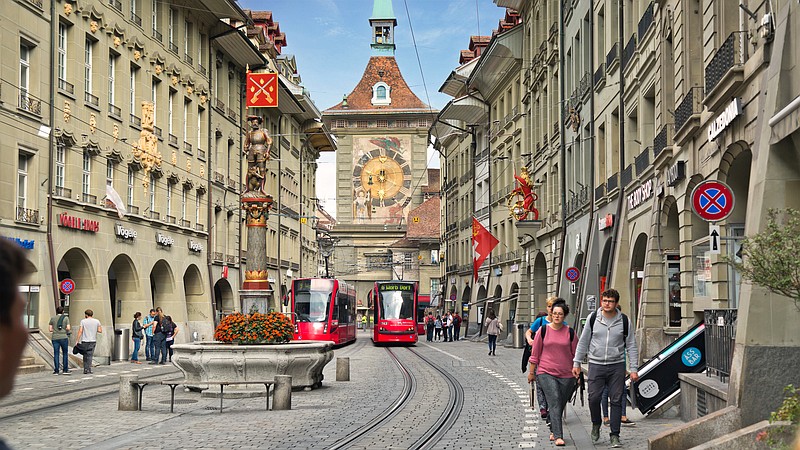The sidewalk along the Aare River is congested with wet and happy Swiss, hiking upstream in swimsuits just to float back into town. I join them -- marveling at how this exercise brings out the silly in a people who are generally anything but goofy.
Every hundred yards a railing with concrete steps leads into the rushing river, which looks glacial blue but is surprisingly warm. Leaping in, I'm immediately caught up in the current and propelled toward the grand capital city of Switzerland amid carefree swimmers and a flotilla of rubber life rafts.
Nearing the Marzilibad park, I stroke over to snare a metal railing. I'm always a bit nervous that I'll miss the last one and rush toward the city's scary weir and, it seems, oblivion. Hanging onto the railing was a tanned and wiry grandmother and several giddy children, clearly enjoying an afternoon going up and down the river.
That evening for dinner, I walk downstream to that scary weir, where a trendy restaurant has been built literally over the rushing river. I enjoy tasty local trout over gapped floorboards as the noisy roar of the racing river masks conversations of the Swiss sipping beer on the open-air sofas.
Strolling along the river after dinner, I pass a man water skiing in the current behind a long, playful bungee cord tied to a tree. I reach two concrete pits that were once home to the city's mascots, a pair of elderly bears, the last of which died in 2009. Thanks to years of agitation by the B.L.M. (Bear Liberation Movement), which demanded better living conditions for the poor old captives of Bern, the city replaced the pits with posher digs for today's mascots. Now one of the original bear pits is a bear-theme bar.
Bern is packed into a peninsula created by a tight bend in the river. Crossing the river from the bear pits I enter the old town -- a delight to explore on foot. The lanes are lined with three miles of arcades, providing lots of shopping opportunities. This is my kind of shopping town: prices are so high, there's no danger of buying. The local slang for the corridor under these arcades is Rohr (German for pipe). To stroll through the town is to go rohren (piping).
As Bern grew over the centuries, each of its successive walls and moats was torn down, providing vast, people-friendly swaths of land. Today these are elongated "squares," popular for markets and outdoor cafés -- the top places to be seen in the evening.
Buildings new and old throughout the city are a uniform gray, from the creamy Bernese sandstone, quarried nearby. In the 16th century, the city commissioned many colorful fountains to brighten up the gray cityscape, to show off the town's wealth, and to remind citizens of great local heroes and events. They also gave local artists something to work on after the Reformation deprived them of their most important patron, the Catholic Church.
Bern's 15th-century cathedral, Catholic-turned-Protestant, is capped by a 330-foot-tall tower, the highest in Switzerland. During the Reformation, religious icons were destroyed by Protestants. The church was originally adorned by 26 separate little chapels and altars dedicated to Mary and the various saints. When the Reformation came to town in 1528, all this was swept away by iconoclasts who believed that images distracted worshippers from focusing on God. The new center of attention was the pulpit from where Protestant preachers shared the word of God -- not in Latin, but in the people's language.
The parliament meets in the old town. You may brush elbows with some high-powered legislators, but you wouldn't know it -- everything looks very casual for a national capital. Its bicameral system was inspired by the U.S. Constitution, with one big difference: executive power is shared by a committee of seven, with a rotating ceremonial president and a passion for consensus. This is a mechanism to avoid power grabs by any single individual -- a safeguard that the Swiss appreciate more than ever these days. Free, one-hour tours of the parliament building are offered in various languages during summer when parliament is not in session.
The fine granite plaza in front of the parliament has 26 squirt fountains (one for each canton, or Swiss state). Oblivious to the fact that half of the Swiss gold stock is buried in the country's Fort Knox under the square, kids dance with each watery eruption.
Though I've said it's almost criminal to spend a sunny Swiss day anywhere but high in the Alps, I'd make an exception for urban but easygoing Bern.
Rick Steves writes European guidebooks, hosts travel shows on public TV and radio, and organizes European tours. This column revisits some of Rick's favorite places over the past two decades. You can email Rick at rick@ricksteves.com and follow his blog on Facebook.
